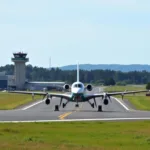Asia, a continent of vibrant cultures and bustling economies, is also home to some of the world’s largest and most impressive airports. These aviation hubs not only connect millions of passengers annually but also play a crucial role in driving economic growth and facilitating global trade. So, which airport holds the title of the Biggest Airport In Asia? Let’s delve into the world of mega-airports and explore the contenders.
Defining “Biggest”: Size Matters, But So Does Capacity
When discussing the biggest airport in Asia, it’s important to clarify what “biggest” actually means. Is it the sheer land area the airport occupies? Or is it the passenger capacity, the number of flights it handles, or perhaps the cargo volume it processes? Each metric paints a different picture and reveals different champions. Some airports sprawl across vast territories, while others maximize efficiency within a more compact footprint.
Land Area Champions
In terms of sheer size, several airports in Asia stand out. For example, King Fahd International Airport in Dammam, Saudi Arabia (while geographically located in the Middle East, it’s often considered part of the Asian aviation landscape) boasts an impressive land area. However, when focusing solely on East and Southeast Asia, airports like Daxing International Airport in Beijing come to mind, known for its modern design and extensive footprint. You can compare it to dubai biggest airport, which is also a massive airport.
Passenger and Cargo Giants
Other airports excel in passenger capacity. Hartsfield–Jackson Atlanta International Airport, while not in Asia, consistently tops global lists for passenger numbers, demonstrating the importance of efficient design and operations. Within Asia, airports like shanghai pudong international airport and Hong Kong International Airport handle massive passenger volumes, connecting millions of travelers annually.
Asia’s Busiest Airports: A Hub of Connectivity
Asia’s bustling economies and growing populations have fueled the rapid development of its airports. These aviation hubs serve as gateways for international trade and tourism, connecting the continent to the rest of the world.
The Rise of Mega-Hubs
The growth of air travel in Asia has led to the emergence of mega-hubs, airports designed to handle massive passenger and cargo volumes. These hubs offer a wide range of destinations, seamless connections, and state-of-the-art facilities. They are often strategically located to serve as regional centers for aviation activity. Consider hong kong international airport shopping for a truly world-class experience.
What Makes an Airport Efficient?
Efficiency is key to the success of any major airport. Factors like optimized runway layout, streamlined passenger processing, and advanced baggage handling systems all contribute to a smoother and more efficient travel experience.
“Efficient airport design is crucial for accommodating the ever-increasing passenger volumes in Asia,” says Dr. Amelia Chen, an aviation consultant based in Singapore. “By optimizing processes and leveraging technology, airports can enhance passenger experience while maintaining high levels of safety and security.”
The Future of Asian Airports
The future of Asian airports is bright, with continued growth and innovation on the horizon. As technology advances, we can expect to see even more efficient and passenger-centric airports emerge, further connecting Asia to the world. For instance, pakistan karachi airport continues to expand and adapt.
Sustainable Aviation
Sustainability is also becoming a key focus in airport development. Airports are increasingly adopting green technologies and practices to minimize their environmental impact. This includes initiatives like renewable energy sources, energy-efficient buildings, and sustainable waste management systems.
“The aviation industry is embracing sustainability,” says Mr. David Lee, an environmental engineer specializing in airport design. “Asian airports are at the forefront of this movement, implementing innovative solutions to reduce their carbon footprint and create a more sustainable future for air travel.” Thinking of scale, you could consider if abu dhabi airport is the biggest in its own right.
Conclusion
The question of the biggest airport in Asia is complex and depends on how you define “biggest.” While some airports boast vast land areas, others excel in passenger capacity and cargo volume. What’s clear is that Asian airports are crucial drivers of economic growth and connectivity, constantly evolving to meet the demands of a dynamic and interconnected world. The continued development and innovation within the Asian aviation landscape promise an exciting future for air travel in the region.
FAQ
- What are the busiest airports in Asia by passenger volume?
- What is the largest airport in Asia by land area?
- What are some of the key features of mega-hub airports?
- How are Asian airports addressing sustainability?
- What technological advancements are shaping the future of Asian airports?
- What factors determine an airport’s efficiency?
- How do Asian airports compare to other major airports around the world?
Need assistance with your travel plans? Contact us at Phone Number: +13089626264, Email: [email protected] Or visit us at: 404 Bothwell St, Oxford, NE 68967, USA. We have a 24/7 customer service team.

